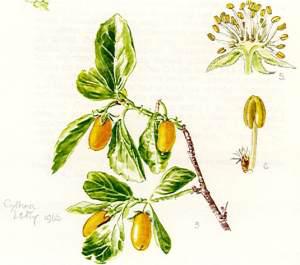Dovyalis zeyheri
Dovyalis zeyheri (Sond.) Warb.
Family: Salicaceae
Common names: wild apricot (E), wilde-appelkoos (A), umNyazuma (Z), umQokokolo (X), morethema (NS)
SA Tree No: 511
Introduction
This is a tree with a most unusual and apparently unexplained feature. At certain times of the year the leaves emit a smell resembling that of carrion. It can be quite strong at times and could lead to a search for a dead animal in the vicinity. It is quite hard to believe that it is coming from a tree!

Description
Description
Dovyalis zeyheri is a small to medium sized evergreen tree growing from 2 - 13 m. The stem can be single- or multi-stemmed. The bark is a light grey-brown, becoming rough and flaking on older trees. Young branches are covered with hairs, and long, straight spines are usually present. These may reach up to 60 mm in length and make this plant a good choice for planting along a perimeter to prevent intruders from entering.

Spines are also a feature of Dovyalis caffra, the Kei apple, which is another member of this genus often grown as a barrier plant. These two plants are fairly similar, but the fruits of the Kei apple are yellow, roundish and slightly larger than those of D. zeyheri. The latter tends to grow into a tree, whereas the Kei apple usually remains bushy. D. zeyheri also occurs naturally further north than D. caffra which is centred in the Eastern Cape region.
The leaves of D. zeyheri are glossy, dark green, alternate and have a leathery texture. Young leaves are soft and velvety. The flowers are small and greenish yellow. Male and female flowers are borne, from August to December, on separate trees. The fruits are found only on female trees. They are bright orange and oval in shape with a velvety texture. They reach up to 25 mm long and appear from November to May.

Distribution and habitat
Distribution description
The wild apricot is widespread and occurs in bushveld and woodlands, especially in rocky areas. It also sometimes occurs in evergreen forest margins. This tree is found in the more easterly parts of South Africa, and central and eastern Zimbabwe.
Derivation of name and historical aspects
History
The name Dovyalis is based on a Greek word meaning "spear", and the specific name, zeyheri, is in honour of K.L.P. Zeyher, a German botanist who was active in South Africa in the early 19th century.
Ecology
Ecology
Birds such as barbets, louries, hornbills and mousebirds relish the fruit. The thorns which provide protection for birds' nests, as well as the fruit, make this an excellent wildlife garden tree. In the wild it is often found growing on termite mounds in areas where the soil has a high clay content. The caterpillars of the African Leopard Butterfly (Phalanta phalantha) feed on the leaves.
Uses
Use
The wild apricot is a good tree for wild fruit. The taste is sour but refreshing and is eaten by people and animals. The fruit makes a good jelly but some sweetening is required.
Growing Dovyalis zeyheri
Grow
In the garden, Dovyalis zeyheri is tolerant of moderate frost, although young plants should be protected for the first two years. It is also drought resistant, and grows well in either full sun or light shade. It grows well in sandy or loamy soil to which compost has been added. The wild apricot is a moderate grower, putting on up to 600 mm per year. If planting the wild apricot for the fruit, then it would be wise to plant several to make sure that at least one is a female! It takes approximately three years for trees to bear fruit. The wild apricot does not have an aggressive root system. A female plant could make an interesting and colourful container plant when in fruit.
Dovyalis zeyheri should be grown from seed. Fruit can be collected when ripe, dried in a shady place and the seeds removed. Alternatively eat the fleshy part and extract the seed that way! Sow the seeds in trays with clean river sand and press into the surface of the sand until they are level with it. Cover with a thin layer of fine sand. Do not allow to dry out. Germination may be erratic but usually occurs within 8 - 14 days. Seedlings can be transplanted but should be watered very well for a week afterward.
References
- Palgraves, K.C. 1981. Trees of Southern Africa. Struik Publishers. Cape Town
- Palmer, E and Pitman, N. 1972. Trees of Southern Africa: Volume 3. A.A. Balkema. Cape Town.
- Pooley, E. 1993. The Complete Field Guide to Trees of Natal, Zululand & Transkei. Natal Flora Publications Trust. Durban
- Van Wyk, B and van Wyk, P. 1997. Field Guide to Trees of Southern Africa. Struik Publishers. Cape Town.
- Venter, F and J-A. 1996. Making the most of Indigenous Trees. Briza Publications. Pretoria.
Credits
Alice Aubrey & Moeketsi Letsela
Walter Sisulu National Botanical Garden
April 2002
Plant Attributes:
Plant Type: Tree
SA Distribution: Eastern Cape, Gauteng, KwaZulu-Natal, Limpopo, Mpumalanga, North West
Soil type: Sandy, Clay, Loam
Flowering season: Spring, Early Summer
PH: Neutral
Flower colour: Green
Aspect: Full Sun
Gardening skill: Average
Special Features:
Horticultural zones









Rate this article
Article well written and informative
Rate this plant
Is this an interesting plant?
Login to add your Comment
Back to topNot registered yet? Click here to register.